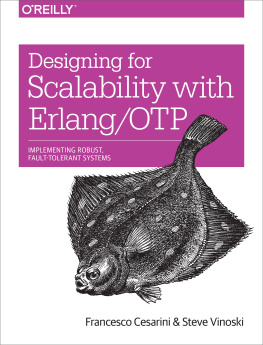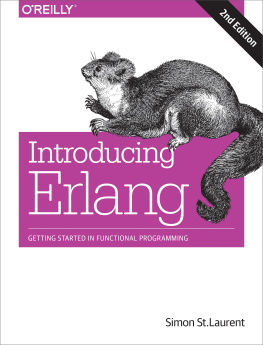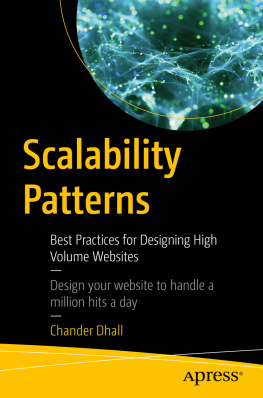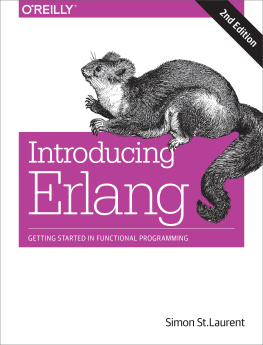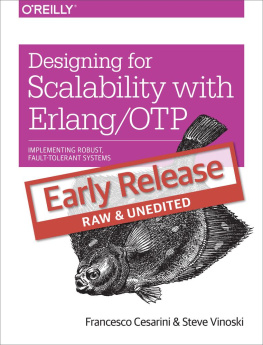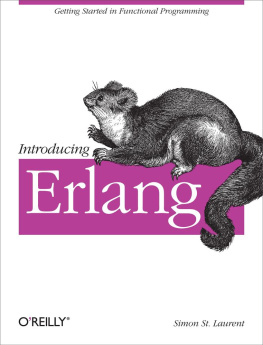Cesarini Francesco - Designing for Scalability with Erlang/OTP
Here you can read online Cesarini Francesco - Designing for Scalability with Erlang/OTP full text of the book (entire story) in english for free. Download pdf and epub, get meaning, cover and reviews about this ebook. City: Sebastopol;CA, year: 2016, publisher: OReilly Media, genre: Computer. Description of the work, (preface) as well as reviews are available. Best literature library LitArk.com created for fans of good reading and offers a wide selection of genres:
Romance novel
Science fiction
Adventure
Detective
Science
History
Home and family
Prose
Art
Politics
Computer
Non-fiction
Religion
Business
Children
Humor
Choose a favorite category and find really read worthwhile books. Enjoy immersion in the world of imagination, feel the emotions of the characters or learn something new for yourself, make an fascinating discovery.
- Book:Designing for Scalability with Erlang/OTP
- Author:
- Publisher:OReilly Media
- Genre:
- Year:2016
- City:Sebastopol;CA
- Rating:3 / 5
- Favourites:Add to favourites
- Your mark:
- 60
- 1
- 2
- 3
- 4
- 5
Designing for Scalability with Erlang/OTP: summary, description and annotation
We offer to read an annotation, description, summary or preface (depends on what the author of the book "Designing for Scalability with Erlang/OTP" wrote himself). If you haven't found the necessary information about the book — write in the comments, we will try to find it.
Designing for Scalability with Erlang/OTP — read online for free the complete book (whole text) full work
Below is the text of the book, divided by pages. System saving the place of the last page read, allows you to conveniently read the book "Designing for Scalability with Erlang/OTP" online for free, without having to search again every time where you left off. Put a bookmark, and you can go to the page where you finished reading at any time.
Font size:
Interval:
Bookmark:
by Francesco Cesarini and Steve Vinoski
Copyright 2016 Francesco Cesarini and Stephen Vinoski. All rights reserved.
Printed in the United States of America.
Published by OReilly Media, Inc. , 1005 Gravenstein Highway North, Sebastopol, CA 95472.
OReilly books may be purchased for educational, business, or sales promotional use. Online editions are also available for most titles (http://safaribooksonline.com). For more information, contact our corporate/institutional sales department: 800-998-9938 or corporate@oreilly.com .
Editor: Andy Oram | Indexer: Lucie Haskins |
Production Editor: Nicholas Adams | Interior Designer: David Futato |
Copyeditor: Christina Edwards | Cover Designer: Karen Montgomery |
Proofreader: Rachel Head | Illustrator: Rebecca Demarest |
- May 2016: First Edition
- 2016-05-11: First Release
See http://oreilly.com/catalog/errata.csp?isbn=9781449320737 for release details.
The OReilly logo is a registered trademark of OReilly Media, Inc. Designing for Scalability with Erlang/OTP, the cover image, and related trade dress are trademarks of OReilly Media, Inc.
While the publisher and the authors have used good faith efforts to ensure that the information and instructions contained in this work are accurate, the publisher and the authors disclaim all responsibility for errors or omissions, including without limitation responsibility for damages resulting from the use of or reliance on this work. Use of the information and instructions contained in this work is at your own risk. If any code samples or other technology this work contains or describes is subject to open source licenses or the intellectual property rights of others, it is your responsibility to ensure that your use thereof complies with such licenses and/or rights.
978-1-449-32073-7
[LSI]
To Alison, Peter and baby Bump for being patient and supportive.
Francesco
To Dooley and Ed, for teaching me how, and to Cindy, Ryan, Erin, Andrew, and Jake, for being why.
Steve
To Joe, Mike, Robert, for making that phone call.
Francesco & Steve
This book is what you get if you put together an Erlang enthusiast who worked on the R1 release of OTP in 1996 and a Distributed Systems specialist who discovered a decade later how Erlang/OTP allows you to focus on the real challenges of systems development while avoiding accidental difficulties.
By describing how OTP behaviors are built and why they are needed, we show you how to use them to architect standalone nodes. In our original proposal to OReilly, we stopped here. But when writing the book, we decided to push the bar further, documenting our practices, design decisions, and common pitfalls when architecting a distributed system. These patterns, through a set of design choices and tradeoffs we make, give us the scalability, reliability, and availability for which Erlang/OTP is well known. Contrary to popular belief, this does not happen magically or out of the box, but it sure is much easier to achieve than with any other programming language out there that does not emulate Erlangs semantics nor run on the BEAM virtual machine.
Someone once told me that writing books is a bit like having children. Once youve written one and are holding your paper copy, excitement takes over, you quickly forget the hard work and sacrifices, and you want to start writing another one. Ive been intending to write the sequel to Erlang Programming (OReilly) since first holding the paper copy in June 2009. I had no children of my own when I started this project, but it ended up taking so long that my second one is now on its way. Whoever said that good things are not worth waiting for?
As with the first book, we based Designing for Scalability with Erlang/OTP on the examples in the Erlang Solutions OTP training material I developed. I used the examples and started explaining them, converting my lectures and approach to teaching into words. When done with a chapter, I went back and ensured the parts students struggled to understand were clear. Questions that were commonly asked by the best students ended up in sidebars, and long chapters were divided into smaller ones. It all went well until we reached Chapter 11 and 12, because there was no unified way of doing release handling or software upgrade. Rather, there were tools, many of them. Some were integrated in our clients build and release cycle, others worked out of the box. Some were unusable. The chapters are what we hope will become the ultimate guide to anyone wanting to understand how release handling and software upgrade of systems works behind the scenes. They also explain what you need to know should you have to troubleshoot existing tools or write your own.
But the real trouble started with Chapter 13. Not having examples or training material, I found myself formalizing what was in our heads and documenting the approaches we take when architecting Erlang/OTP systems, trying to align it with the theory of distributed computing. Chapter 13 turned into four chapters that took as long to write as the first ten. For those of you who bought the early access, I hope the wait was worth it. For those who wisely waited for us to finish before buying your copy, enjoy!
I first discovered Erlang/OTP in 2006 while researching ways to develop enterprise integration software faster, cheaper, and better. No matter how I looked at it, Erlang/OTP was clearly superior to the C++ and Java languages my colleagues and I had long been using at that time. In 2007 I joined a new company and began using Erlang/OTP for a commercial product, and it turned out to be everything my earlier investigation promised it would be. I taught the language to some colleagues and before long, fewer than a handful of us were developing software that was more capable, more reliable, easier to evolve, and ready for production far faster than similar code being written by a significantly larger team of C++ programmers. To this day I remain wholly convinced of the impressive practical effectiveness of Erlang/OTP.
Over the years Ive published quite a bit of technical material, and my intended audience for all of it has always been other practitioners like me. This book is no exception. In the first 12 chapters we provide the deep level of detail that practicing developers need in order to fully understand the fundamental design principles of OTP. With those details we mix a number of useful nuggets of practical knowledgemodules, functions, and approaches that will save you significant time and effort in your day-to-day design, development, and debugging efforts. In the final four chapters we shift gears, focusing more on the big picture of the tradeoffs involved in developing, deploying, and operating resilient, scalable distributed applications. Due to the staggering amount of knowledge, approaches, and tradeoffs involved in distributed systems, fault tolerance, and DevOps, writing these chapters concisely proved difficult, but I believe we hit just the right balance of providing plenty of great advice without getting lost in the weeds.
I hope this book helps you improve the quality and utility of the software and systems you develop.
This books intended audience includes Erlang and Elixir developers and architects who have made their way through at least one of the introductory books and are ready to take their knowledge to the next level. It is not a book to start off with, but rather the book that picks up where all others leave you. Chapters 312 build on each other and should be read sequentially, as do Chapters 1316. If you do not need an Erlang primer, feel free to skip Chapter 2.
Font size:
Interval:
Bookmark:
Similar books «Designing for Scalability with Erlang/OTP»
Look at similar books to Designing for Scalability with Erlang/OTP. We have selected literature similar in name and meaning in the hope of providing readers with more options to find new, interesting, not yet read works.
Discussion, reviews of the book Designing for Scalability with Erlang/OTP and just readers' own opinions. Leave your comments, write what you think about the work, its meaning or the main characters. Specify what exactly you liked and what you didn't like, and why you think so.

